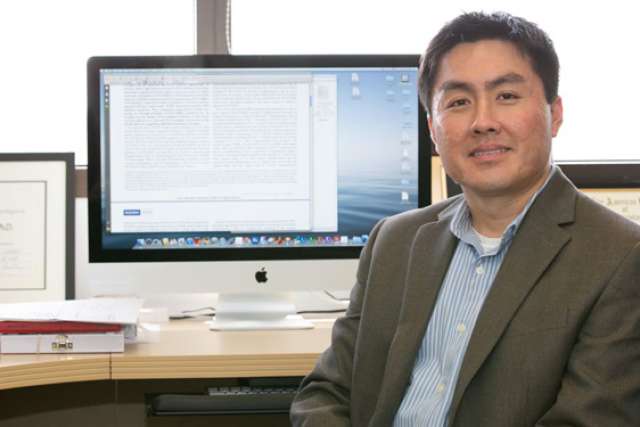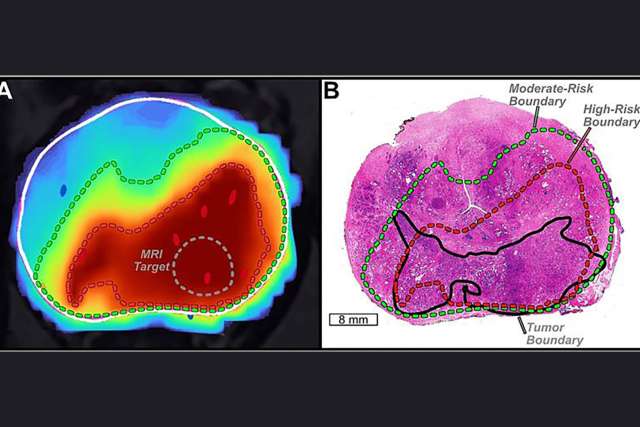A second mutation found in the tumors of patients with BRAF-mutated metastatic melanoma does not contribute to resistance to BRAF inhibitor drugs, a finding that runs counter to what scientists expected to be true.
The study by researchers at UCLA’s Jonsson Comprehensive Cancer Center found that patients with the mutations in both the MEK1 and BRAF genes respond as well to the inhibitors as patients with the BRAF mutation alone.
Another surprising finding is that the MEK1 and BRAF mutations exist together in these patients, despite the fact that they drive the same cell signaling pathway. That discovery also bucks conventional wisdom, said study senior author Dr. Roger Lo, an assistant professor of dermatology and molecular and medical pharmacology and a Jonsson Cancer Center scientist.
“This study is a good example of why scientists should not always rely on what we expect to find,” Lo said. “We expected that this second mutation was involved in drug resistance and it wasn’t. We also expected that only one mutation would exist in this signaling pathway, and that also was wrong.”
The study appears April 1, 2012 in the early online edition of Cancer Discovery, a peer-reviewed journal of the American Association of Cancer Research.
About 50 percent of patients with metastatic melanoma, or 4,000 people a year, have the BRAF mutation and can be treated with the inhibitor Zelboraf, two pills taken twice daily. Zelboraf was approved by the U.S. Food and Drug Administration for use in metastatic melanoma in August 2011. Many other common human cancers, including colon, thyroid and lung, also harbor BRAF-mutated subsets, Lo said.
Use of BRAF inhibitors led to a response in about 60 percent of those with the mutation, Lo said. After responding initially, most of those patients become resistant to the drug. Lo and his team of Jonsson Cancer Center scientists have been studying the mechanisms of resistance to see if they can either prevent it or find a way to re-sensitize the tumor to treatment. It was part of this work that led Lo to examine what role the MEK1 mutation might or might not be playing in that resistance.
“MEK1 is rarely mutated in cancers, but we found in this study that it was frequently associated with BRAF mutations,” Lo said. “The presence of both mutated MEK1 and BRAF might have been considered a biomarker for patients who would not respond to BRAF inhibitors. We were quite surprised when we found that patients with both mutations respond to BRAF inhibitors as well as those with only the BRAF mutation.”
To explore the association between the two mutations, Lo and his team analyzed tumor samples from 31 melanoma patients treated with a BRAF inhibitor. Among those patients, 16 percent of samples carried the double mutations in tumors before the cancer was treated, Lo said. The findings were confirmed using melanoma cell lines grown in Lo’s laboratory.
Going forward, Lo and his team will look at approaches using inhibitors of MEK1 with BRAF inhibitors to determine if patients with the double mutations respond better and for longer periods. They will also try to understand why MEK1 mutations occur quite frequently among melanomas. About 15 percent of the patients with BRAF mutations also have a mutated MEK1, Lo said.
“As BRAF inhibitors gain widespread use for advance melanoma treatment, biomarkers for drug sensitivity or resistance are urgently needed,” the study states. “We identify here concurrent activating mutations in BRAF and MEK1 in melanomas and show that the presence of a downstream mutation in MEK1 does not necessarily make BRAF mutant melanomas resistant to BRAF inhibitors."
About 70,000 new cases of melanoma are diagnosed each year in the United States. Of those, 8,000 people will die of the disease.
The study was funded by the Bud and Sue Selig Innovative Research Grant from Stand Up to Cancer, Burroughs Wellcome Fund, the Seaver Institute, the Richard C. Seaver Charitable Trust, National Cancer Institute, STOP CANCER, V Foundation for Cancer Research, Melanoma Research Foundation, Melanoma Research Alliance, American Skin Association, Caltech-UCLA Joint Center for Translational Medicine, Sidney Kimmel Foundation for Cancer Research, Eli and Edythe Broad Center of Regenerative Medicine and Stem Cell Research at UCLA, Wendy and Ken Ruby and Louise Belley and Richard Schnarr.




